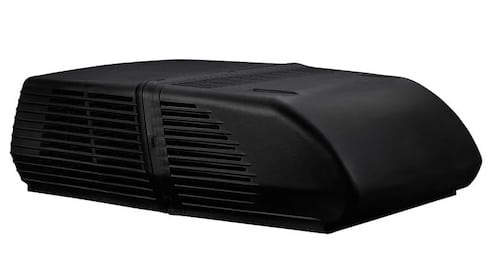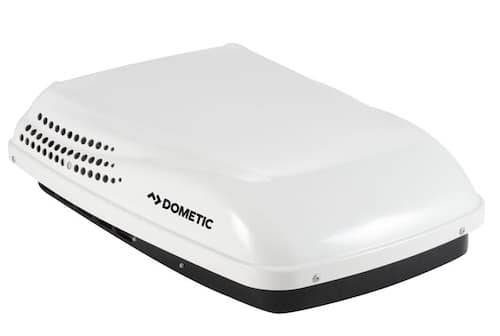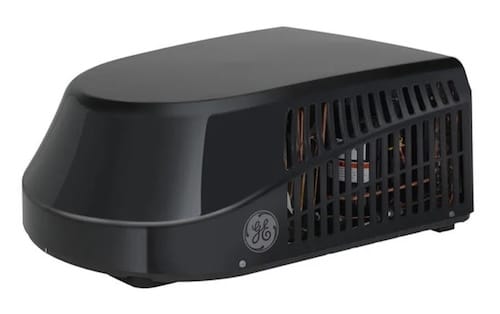Your RV roof air conditioner is without doubt one of the most important home equipment for local weather management, particularly should you camp within the spring or summer time. It’s the rationale most campers finally improve from tent tenting to RVing. Whether or not you need to change, add, or improve your RV air conditioner, we’re right here to assist.
Study every little thing you must find out about RV air conditioners, from selecting the best dimension to making sure you’ve all the proper components.
Key Takeaways
- RV air conditioners are available in a number of sorts: roof-mounted (ducted or non-ducted), window, and moveable models. Every has execs and cons based mostly on cooling energy, set up, house, and effectivity.
- Choosing the proper RV A/C depends upon components reminiscent of RV dimension, BTU ranking, energy supply, model compatibility, thermostat kind, and desired additional options (e.g., warmth pump, comfortable begin, condensate pump, and so forth.).
- Prime rooftop A/C fashions from Dometic, Furrion, Coleman-Mach, GE, and others supply various cooling capacities, profiles, and options; correct generator sizing and non-compulsory A/C covers assist optimize efficiency and longevity.
Kinds of RV Air Conditioners
The preferred kind of air conditioner is an overhead RV A/C put in on the roof. This kind blows air instantly into the RV or distributes it by way of a ducting system. In recent times, we’ve seen an emergence of window and wall-mounted models, particularly in smaller RVs. Whereas much less frequent, moveable RV air conditioners will also be present in trendy RVs.
Need assistance figuring out which is greatest for you? Let’s evaluation the perfect RV air conditioners by kind.
RV Roof Air Conditioners

The preferred, and for good cause, RV roof air conditioners don’t take up any house contained in the RV. They’re the best at distributing air, particularly in a ducted system. These models present probably the most environment friendly cooling, and lots of also can ship warmth when you have a mannequin with a warmth pump or strip. Though main the charts in efficiency, in addition they lead the charts in energy draw and substitute price.
| Professionals | Cons |
| Highly effective | Costly to Change |
| Don’t Take Up Inside House | Massive Energy Draw |
| Warmth Pump Choice | Provides to Total RV Peak |
Ducted versus Non-Ducted RV A/C Items
There are two sorts of roof-mounted A/C models: ducted and non-ducted. In a ducted system, ducts run by way of the RV’s flooring, partitions, or ceiling, and vents ship the air all through the ground plan.
A non-ducted system has just one vent on the distribution field. Air blows straight down from the unit into the RV. Non-ducted methods are customary for small RVs, whereas ducted methods are frequent in bigger RVs with a number of rooms.
Distribution packing containers are normally particular to ducted or non-ducted RVs, so that you’ll have to know which kind you’ve earlier than deciding on one.
RV Window A/C Items

One situation with utilizing an overhead air conditioner on a small camper is the potential to freeze you. Most producers take into account a small RV air conditioner to be 13,500 BTU, which is an excessive amount of for a small RV, even on the bottom setting. With a smaller RV, you additionally possible have a extra restricted energy provide, and window models draw about half as a lot energy as an overhead A/C, on common.
| Professionals | Cons |
| Gained’t Freeze You Out | Takes Up Wall House |
| Smaller Energy Demand | Ugly |
| No Addition to RV Peak | Much less Environment friendly Cooling |
Transportable RV Air Conditioners

A conveyable air conditioner is more than likely utilized in an RV to complement a roof or wall-mounted unit. Its downsides embody lowered cooling capability, added setup time, and lowered cupboard space. Nevertheless, it additionally has positives, reminiscent of quiet operation and fewer pressure in your pockets.
Transportable air conditioners are additionally an possibility for RVs with out an air conditioner or a short lived A/C substitute. The very best half is that including one doesn’t require vital modifications, like chopping into the roof or partitions.
| Professionals | Cons |
| Straightforward Set up | Poor Effectivity |
| Straightforward to Transfer Design | Requires Setup |
| Price Efficient | Takes Up Storage House |
How To Select an RV Air Conditioner
The selection of an RV air conditioner could be overwhelming. There may be an limitless listing of choices and loads of compatibility issues. Let’s go over some frequent deciding components that will help you make an acceptable alternative.
Model
There are two faculties of thought behind selecting the best RV air conditioner model. The primary is selecting the identical model you’ve now to make sure compatibility. The second is selecting a special model, with the expectation that you will have to interchange a number of elements to make sure every little thing works collectively. It’s a good suggestion to select one that provides a system with the options you want. Listed below are among the prime RV air conditioner manufacturers:
Measurement (BTU Score)
When most individuals discuss an RV air conditioner’s dimension, they consult with its BTU ranking. British Thermal Items, also called BTUs, are primarily a measure of energy. The upper the BTU ranking, the higher its cooling capability. Most producers supply a smaller 13,500 BTU RV air conditioner and a bigger 15,000 BTU RV air conditioner. There are some oddball rankings as properly, reminiscent of 11,000 BTU for smaller RVs.
A number of components, reminiscent of the dimensions of the RV, insulation properties, and variety of rooms, have to be thought of when selecting the proper dimension (AKA BTU ranking) in your RV. We advocate sticking with the producer’s suggestion, which you will get by calling the producer instantly together with your automobile identification quantity (VIN).
In case your camper didn’t include an air conditioner and also you need to add one, you should utilize the overall dimension chart under as an estimate.
| RV Size | BTU Requirement |
| <20 | 13,500 |
| 20-30 | 15,000 |
| >30 | 27,000-30,000 |
Handbook or Electrical
A handbook system is managed by way of the distribution field, so you have to modify settings instantly on the ceiling or wall-mounted RV air conditioner. This will likely pose a problem should you’re shorter or have a excessive ceiling.
An electrical system makes use of a wall-mounted thermostat for operation. Though most choose a wall thermostat, handbook methods are simpler to put in since you don’t must run wires by way of the partitions and ceiling.
Options
There are a lot of options to think about, however not all manufacturers supply the identical choices. It’s sensible to pick out solely what you want. Typically, the extra options it has, the dearer it will likely be. A number of examples of normal options are listed under:
- Warmth Pump – Supplies additional warmth in colder months. Works greatest above 40 levels Fahrenheit.
- Warmth Strip – Designed to take away the nippiness, it shouldn’t be a major warmth supply.
- Delicate Begin – Reduces start-up power calls for, permitting for a smaller generator.
- Condensate Pump – Channels condensation away from the roof and out a drain tube.
- RV Air Conditioner Delicate Starter – Reduces the quantity of energy wanted to begin your A/C. Nice for boondocking.
Finest RV Air Conditioner Fashions to Take into account
Our top-rated RV air conditioners will enable you discover a dependable system to maintain you cool this summer time.
Dometic FreshJet 3 Collection RV Air Conditioner

Probably the most revolutionary rooftop air conditioner on the listing is a Dometic RV air conditioner, the FreshJet 3. The FreshJet provides upgraded effectivity, quieter operation, and e-coated coils for added sturdiness.
| Profile Peak (in.) | Weight (lbs) | Score (BTUs) |
| 13.8” | 64-66 | 13,500 or 15,000 |
Furrion Chill HE RV Roof Air Conditioner

The Furrion Chill is a extremely environment friendly rooftop air conditioner with sturdy options like vibration safety and a thermal-insulated shroud.
| Profile Peak (in.) | Weight (lbs) | Score (BTUs) |
| 13.5” | 82-93 | 13,500 or 15,000 |
Coleman Mach Quiet Collection 15 Air Conditioner

The Coleman Mach is without doubt one of the most tried-and-true RV rooftop air conditioners. This high-performance air conditioner provides superior cooling and unequalled sturdiness.
| Profile Peak (in.) | Weight (lbs) | Score (BTUs) |
| 13.8” | 83.5 | 15,000 |
Dometic Penguin II Excessive-Capability Air Conditioner

What’s distinctive in regards to the Penguin is its low-profile design, which improves aerodynamics and helps minimize down on gasoline prices. Pair this with a high-performance motor for max cooling energy, and you’ve got a wonderful rooftop RV air conditioner.
| Profile Peak (in.) | Weight (lbs) | Score (BTUs) |
| 11.25” | 101 | 13,500 |
GE R32 Deluxe RV Air Conditioner

The GE air conditioner is cost-effective and dependable. It has rubber grommets to cut back vibrations, a shiny shroud to extend aesthetics, and easy-to-maintain coils for cleansing.
| Profile Peak (in.) | Weight (lbs) | Score (BTUs) |
| 13.9” | 80 | 13,500 |
What Are the Completely different Rooftop Air Conditioner Parts?
RV roof air-con methods are a set of elements that work collectively to ship cool air all through your camper. The primary ingredient is your roof-mounted unit, adopted by the distribution field, a management module, and the thermostat. Some models come as a package with all of the wanted objects, whereas others require you to buy them individually. Right here’s how every element within the system capabilities:
The A/C Unit

The primary element of an air conditioner for RV roofs is the unit itself. The unit incorporates all the interior air-con components, such because the coils, condenser, compressor, and so forth.
Distribution Field

The distribution field is mounted contained in the RV to the ceiling instantly under the A/C unit. It distributes air all through the RV by way of one or a number of vents.
Management Module
The management module is mounted to the distribution field or contained in the unit. It controls all of the settings, reminiscent of air pace and temperature. It’s the system’s mind that communicates with the A/C unit, distribution field, and thermostat.
Thermostat

The thermostat tells the A/C unit when to activate/off. It may be mounted on the wall (electrical) or to the distribution field (handbook).
Shroud

The shroud protects the interior elements of the A/C unit. Sometimes constructed of polypropylene, these covers are sturdy and weather-resistant.
Air Filter
The air filter is put in contained in the distribution field in entrance of the vent. It blocks allergens, reminiscent of mud, pollen, mould spores, and extra, from coming into the RV.
What Measurement Generator Do I Want for My Air Conditioner?

Typically, most 13,500 BTU RV air conditioners would require at the very least 3,500 beginning watts, and 15,000 BTU RV air conditioners will want upwards of 4,000 beginning watts.
When tenting off-grid, there’s no entry to shore energy. Air conditioners draw an excessive amount of energy in your batteries, forcing you to make use of a moveable RV generator. Sadly, generator sizing could be tough. Because of house, weight, and gasoline issues, you’ll normally need to use a generator that’s as small as attainable.
Like mills, most air conditioners have working and beginning wattage necessities. Beginning watts characterize how a lot energy the unit requires on startup, and working watts characterize how a lot energy it wants to remain working. The beginning watts could be virtually double the working watts. An A/C comfortable begin can cut back the ability beginning necessities.
Study extra on this generator sizing information.
Do I Want An Air Conditioner Cowl?
In case you don’t have an RV cowl, a rooftop air conditioner cowl is noteworthy for safeguarding the meeting when your RV is in storage. Use an air conditioner cowl to forestall mud, particles, moisture, and different probably damaging substances from negatively impacting your important elements.
Use these further sources to study extra, improve, or troubleshoot:
Tell us what RV air conditioner unit you like or when you have any questions within the feedback under.

